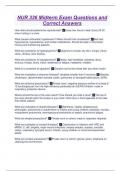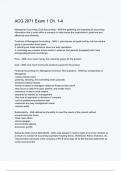NUR 336 Midterm Exam Questions and
Correct Answers
How often should patients be repositioned? ✅Every two hours in bed. Every 20-30
mins if sitting in a chair.
What causes orthostatic hypotension? When should it be considered? ✅Bed rest,
hypovolemia, hypokalemia, and certain medications. Should be kept in mind when
moving and transferring patients.
What are symptoms of hyperglycemia? ✅Urgency to urinate, dry skin, hungry, blurry
vision, drowsy, slow healing.
What are symptoms of hypoglycemia? ✅Shaky, fast heartbeat, sweating, dizzy,
anxious, hungry, blurry vision, weakness or fatigue, headache, irritable.
What is a constraint for glargine? ✅Glargine cannot be mixed with any other insulin.
What are examples of airborne illnesses? (droplets smaller than 5 microns) ✅Measles,
chickenpox, disseminated varicella zoster, pulmonary or laryngeal tuberculosis, SARs.
What are airborne precautions? ✅Private room, negative pressure airflow of at least 6-
12 exchanges per hour via high-efficiency particulate air (HEPA) filtration, mask or
respiratory protection device.
Where should the top of the cane reach? How should you hold a cane? ✅The top of
the cane should reach the crease in your wrist. Hold cane in hand opposite of the side
that needs support.
What are examples of droplet illnesses? ✅Diphtheria, rubella, streptococcal
pharyngitis, pneumonia or scarlet fever in infants and young children, pertussis, mumps,
mycoplasma pneumonia, meningococcal pneumonia or sepsis, pneumonic plague.
What are droplet precautions? ✅Private room or cohort, mask or respirator required.
What are examples of contact illnesses? ✅Colonization or infection with VRE and
MRSA, C. diff, shigella, major wound infections, herpes simplex, scabies, varicella
zoster, respiratory syncytial virus in infants, young children or immunocompromised
adults.
What are contact precautions? ✅Private room or cohort, gloves, gown, emphasis on
cleaning the environment.





